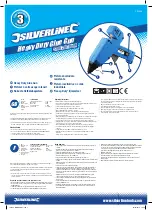
English
1
EN
FR
DE
ES
IT
NL
PT
DA
SV
FI
NO
RU
PL
CS
HU
RO
LV
LT
ET
HR
SL
SK
EL
TR
WARNING
Read all safety warnings and all instructions.
Failure
to follow the warnings and instructions may result in
electric shock,
fi
re and/or serious injury.
Save all warnings and instructions for future reference
.
NAILER SAFETY WARNINGS
a)
Always assume that the tool contains fasteners.
Careless handling of the nailer can result in unexpected
firing of fasteners and personal injury.
b)
Do not point the tool towards yourself or anyone
nearby.
Unexpected triggering will discharge the
fastener causing an injury.
c)
Do not actuate the tool unless the tool is placed
firmly against the workpiece.
If the tool is not in
contact with the workpiece, the fastener may be
deflected away from your target.
d)
Disconnect the tool from the power source when the
fastener jams in the tool.
While removing a jammed
fastener, the nailer may be accidentally activated if it
is plugged in.
e)
Use caution while removing a jammed fastener.
The mechanism may be under compression and the
fastener may be forcefully discharged while attempting
to free a jammed condition.
f)
Do not use this nailer for fastening electrical cables.
It is not designed for electric cable installation and
may damage the insulation of electric cables thereby
causing electric shock or fire hazards.
ADDITIONAL SAFETY WARNINGS
a) Always be aware that misuse and improper handling of
this tool can cause injury to yourself and others.
b) The tool is designed for single-hand use. Do not hold
the tool by the front of the magazine. Do not put hands,
head, or other parts of your body near the bottom of
the magazine where the nail exits the tool, as serious
personal injury could be caused.
c) Always ensure that the workpiece contact is fully
positioned above the workpiece. Positioning the
workpiece contact only partially above the workpiece
could cause the nail to miss the workpiece completely
and result in serious personal injury.
d) Do not drive nails near edge of material. The workpiece
may split causing the nail to ricochet, injuring you or a
coworker. Be aware that the nail may follow the grain of
the wood, causing it to protrude unexpectedly from the
side of the work material or deflect, possibly causing
injury.
e) Keep hands and body parts clear of immediate work
area. Hold workpiece with clamps when necessary to
keep hands and body out of potential harm. Be sure
the workpiece is properly secured before pressing the
fastener against the material. The workpiece contact
may cause the work material to shift unexpectedly.
f) Keep face and body parts away from back of the tool
cap when working in restricted areas. Sudden recoil
can result in impact to the body, especially when nailing
into hard or dense material.
g) During normal use the tool will recoil immediately after
driving a fastener. This is a normal function of the tool.
Do not attempt to prevent the recoil by holding the nailer
against the work. Restriction to the recoil can result in
a second fastener being driven from the nailer. Grip
the handle firmly, let the tool do the work and do not
place second hand on top of tool or near exhaust at any
time. Failure to heed this warning can result in serious
personal injury.
h) Do not drive fasteners on top of other fasteners or with
the tool at an overly steep angle as this may cause
deflection of fasteners which could cause injury.
i) Always check the work area for hidden wiring, gas lines,
water lines, etc., before using the product on such work
area.
j) After using the product in the contact actuation mode,
switch it back to the full sequential mode.
k) The driving depth of the nail may be adjusted beyond
air pressure. It is advisable to test the depth on a scrap
workpiece to determine the required depth for the
application.
l) Only fasteners matching the description in the product
specification table can be used with this tool. Using
incorrect fasteners may lead to jamming or other
malfunctions.
DEPTH ADJUSTMENT SAFETY WARNINGS
a) Always remove the battery before adjusting the depth
of drive wheel.
b) Do not pull back on the adjustment wheel, the wheel is
designed to be rotated.
c) Do not press the trigger while adjusting the depth of
drive wheel.
d) Always select full sequential firing mode before
adjusting the depth of drive.
e) Do not point the tool towards yourself or anyone nearby
when adjusting the depth of drive.
TRANSPORTING LITHIUM BATTERIES
Transport the battery in accordance with local and national
provisions and regulations.
Follow all special requirements on packaging and labelling
when transporting batteries by a third party. Ensure that
no batteries can come in contact with other batteries
or conductive materials while in transport by protecting
exposed connectors with insulating, non-conductive caps
or tape. Do not transport batteries that are cracked or
Summary of Contents for R18N16G
Page 2: ...si...
Page 32: ...30 l a b c d e a b c d e...
Page 33: ...31 EN FR DE ES IT NL PT DA SV FI NO RU PL CS HU RO LV LT ET HR SL SK EL TR Ga...
Page 56: ...54 a b c d e a b c d e...
Page 57: ...55 EN FR DE ES IT NL PT DA SV FI NO RU PL CS HU RO LV LT ET HR SL SK EL TR CE EurAsian Ga...
Page 60: ...58 2 6 1 0 1 2 3 4 5 inch cm 13 12 11 10 9 8 7 6 5 4 3 2 1 0 cm 13 12 11 5 4 3 2 0 inch 1 2 5...
Page 64: ...62 0 1 2 3 4 5 inch 2 0 1 2 3 4 5 inch 4...
Page 103: ......
Page 104: ...961152310 01...




































